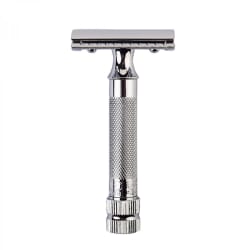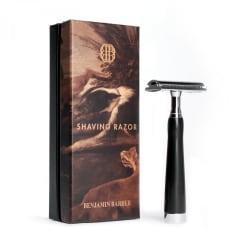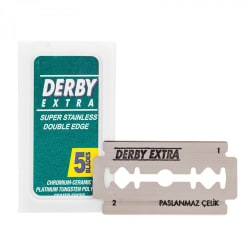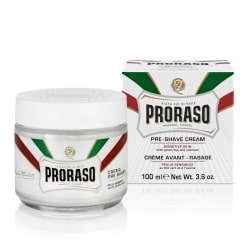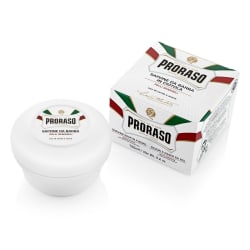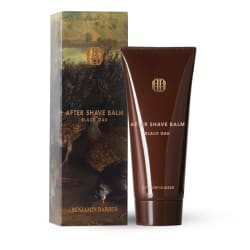shaving tips for sensitive skin
Written with barber Simon
Getting out the razor is undeniably difficult if you have skin that wants to protest in the form of rashes, redness or ingrown hairs. But there is help available and with the right tools and techniques, nothing is impossible. Here are some tips along the way.

Sensitive skin can have many causes and manifestations - many sufferers of this condition usually give up on shaving and reach for the razor instead. This is not surprising, as shaving is a dehydrating and stressful process for facial skin. Often, dryness is one factor associated with sensitive skin such as clay and long straw, another is sensitivity to friction. Some, like many redheads, have skin that is basically intolerant of overly irritating treatment. But it is a mistake to think that shaving is completely out of the question in such circumstances, at least for the vast majority. Sometimes it's enough to change the shaving tools, but it's not uncommon to find products on the market, whether pre-shave, lather or after-shave, that alleviate or even cure the problem.
shaving tools
A major culprit is often the modern-day multi blade system Gillette or similar designs that are often the standard razor for most people from adolescence and well into adulthood. Even here we can often find the root of the problem, as a multi-blade head with three or more closely spaced blades often creates significant friction - and it is precisely this friction that causes problems for the skin. There are two reasons for this: firstly, the blades are sharpened in such a way that they do not come close enough to the skin - this creates a movement effect that irritates - and secondly, the number of closely spaced blades multiplies the damage. The result is thus a significant strain on the skin, which is further aggravated by the fact that, because of the blades' poorer penetration, people like to tear and pull in different directions - often several times in the same place. In short, this is not a treatment that an already sensitive skin appreciates. In addition, many multi-leaf users only protect their skin by applying an ordinary foam from a spray can, whose thin consistency often does not protect the skin surface sufficiently.
The solution to this is instead a traditional safety razor whose sharp double blades have a different grind, resulting in a closer shave to the skin. The friction created is also much less (and therefore irritation) as you need to apply as little pressure as possible. The rule is that you should have to work with as little pressure as possible and still be as clean-shaven as possible. The skin feels better and you get a more effective shave.
.Already here you can go a long way, and for most people a safety razor with a standard head (closed comb) is sufficient, such as Merkurs 34C or 38C (short or long handle) or any of the following Sailor's estimated planes.
But there are also specialised models particularly suited to sensitive skin such as the so-called slant plane, an ingenious early 20th century patent with a curiously twisted head. The slant plane comes most commonly with an ordinary closed comb as in the German Merkur but otherwise it works differently. Instead, the contorted shape of the slant plane means that it slices off the hairs at a completely different angle to other planes, which means that the blade comes incredibly close to the skin and creates absolutely zero friction - hence its amazing gentleness on the skin. However, a warning should be issued to new users of safety planes about this design: because the blades are so extremely close to the skin, it's easy to nod off if you're not used to it, as you simply can't feel it working. But once you get used to the feel, it's a blessing for sensitive skin - especially as it's automatically extra light on the hand too. You don't have to worry about the angle - it takes care of that and you work with the same technique as usual. Available with both short and long handles.
technique
Many people over-dramatise the safety razor because of its sharp reputation, but if you're just aware that you shouldn't push, you'll soon realise that there are some rather exaggerated, nasty myths surrounding these handy tools. Many people who use modern multi-blade razors discover quite early on that shaving against the grain is often impossible (and the dilemma here is often that this is unfortunately what is required if you want to be clean-shaven with these) - the skin simply takes too much of a beating, not least in such a critical area as the neck. Not infrequently, many have therefore been taught that it is "wrong" or bad to shave against the grain.
With a safety razor, with its minimal friction and light touch on the skin, most people can actually shave both with and against the grain without major problems. It should be noted, however, that there are a few cases that simply can't shave against the grain with any tool, especially those with skin with superficial blood vessels and a tendency to crack, but these are generally the unfortunate exceptions. One consolation is that with a safety razor you still get so much more cleanly shaved than with a modern multi-blade razor, so driving with hair is still enough for a good and neat result.
blades
The so-called double edge blades for safety planes have the advantage that they all have the same handle and fit all such planes - the only difference between the brands is the sharpness and sometimes the thickness (the latter is less important for most people and is a matter of taste). The basic rule for all safety razors is to have as sharp a blade as you can manage because you simply must never be tempted to start pushing. This is especially true for those with sensitive skin - in fact - and that's because it's rarely the sharpness that's harmful but ... yes, the friction. If you have very sensitive skin or don't have the world's toughest beard growth, you may not need to go all out with the Japanese beast. Feather but at least Derby Extra or the slightly thicker Derby Black Premium should suit most people. Avoid leaves that are too sharp!
pre-shave, shaving cream and post-shave
A good tip if you have troublesome irritated skin is to pre-prepare it before shaving with a pre-shave. Many people follow the lead of traditional barbers and use a shaving oil, which provides an extra layer of protection and improves glide so that the tool works better on its own. A very good alternative is otherwise the clever pre-shave cream from Proraso and here we mainly recommend the "white" one containing green tea and oat milk - both ingredients are particularly nourishing and here they are combined. Also with a fresh clean scent without much perfume. This provides a perfect barrier due to its paste-like texture and is also rich: apply a very thin layer to warm damp skin and let it sit for a minute or two before applying the shaving cream - do not rinse off the pre-shave!
Then we come to the shaving cream. Using canned shaving foam is hardly recommended for sensitive skin, but here's the shaving cream or shave soap both of which deliver a rich, full-bodied lather that really protects and is worked up with warm water (for the shaving soap, the shaving brush necessary to be able to work up the lather while the shaving cream can be lathered up even with your fingers).
What about after shaving? As a rule, sensitive skin automatically means dry skin and since shaving is dehydrating in itself, it is absolutely recommended to use a so-called post shave afterwards to calm the skin and moisturise it. (Avoid after shave lotion/splash with alcohol!) There are several good ones after shave balms in cream form to choose from if you have a sensitive skin type, such as Proraso's white Sensitive Green Tea (with the same content as the pre-shave mentioned above) or the one with aloe vera but a tip for those with more serious skin problems is Benjamin Barbers bright Post Shave Gel with salicylic acid and extra nourishing ingredients, which is particularly effective against razor burn, irritation and even ingrown hairs.
TIPS! For those with ingrown hairs, regular use a couple of days a week with an exfoliating scrub may also be recommended. Peeling cream which removes excess sebum and dead skin debris - factors that often cause hair to grow.inwards.
MORE ABOUT SENSITIVE SKIN TYPES

